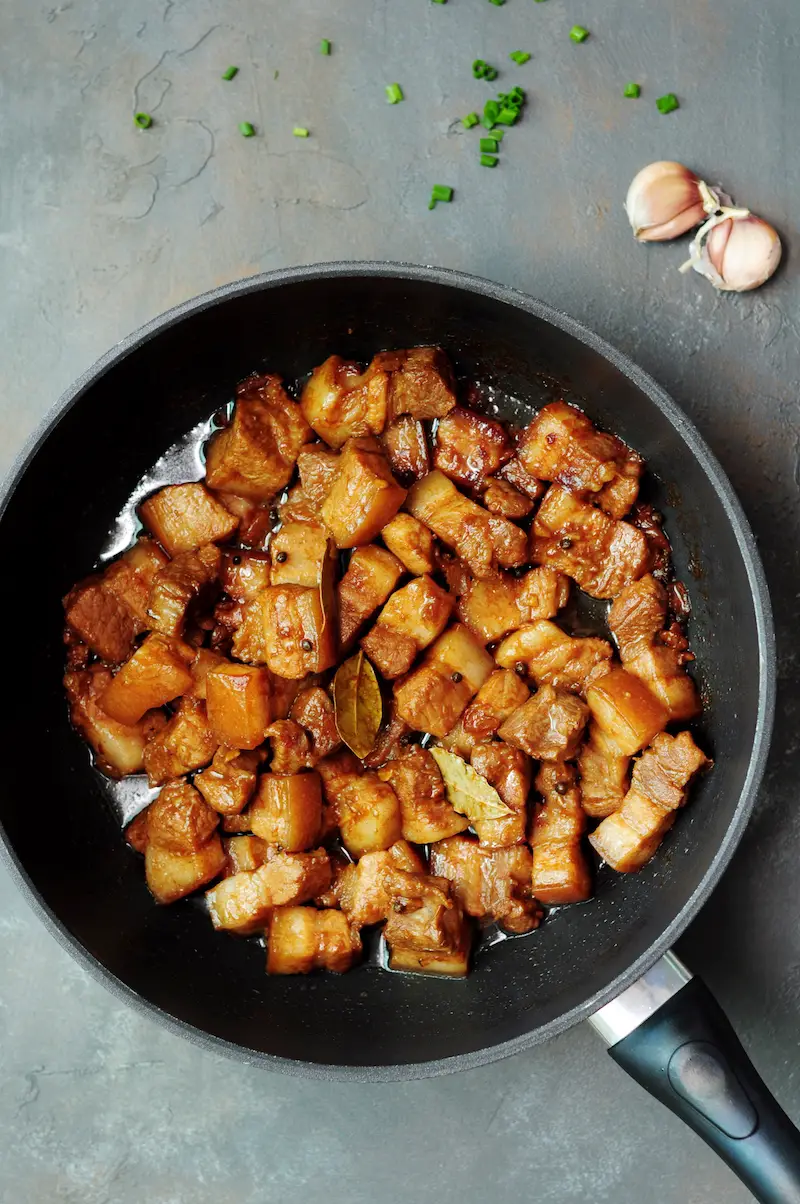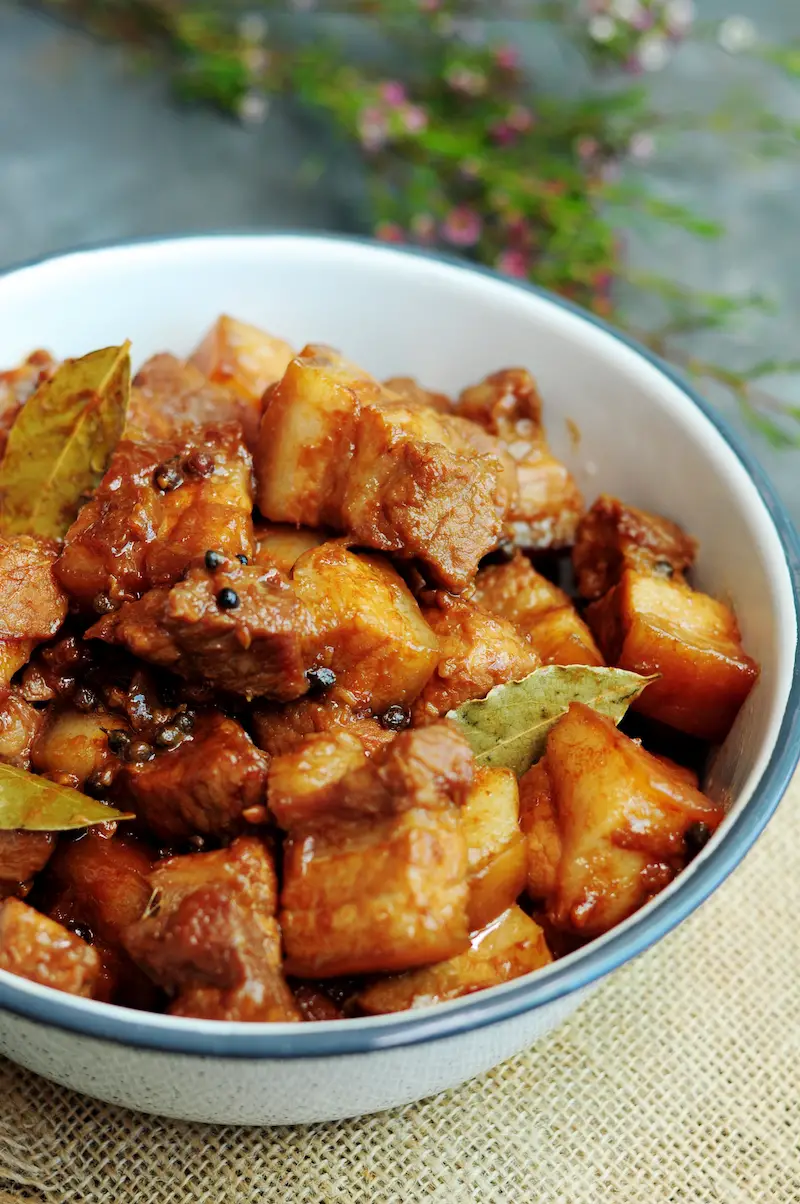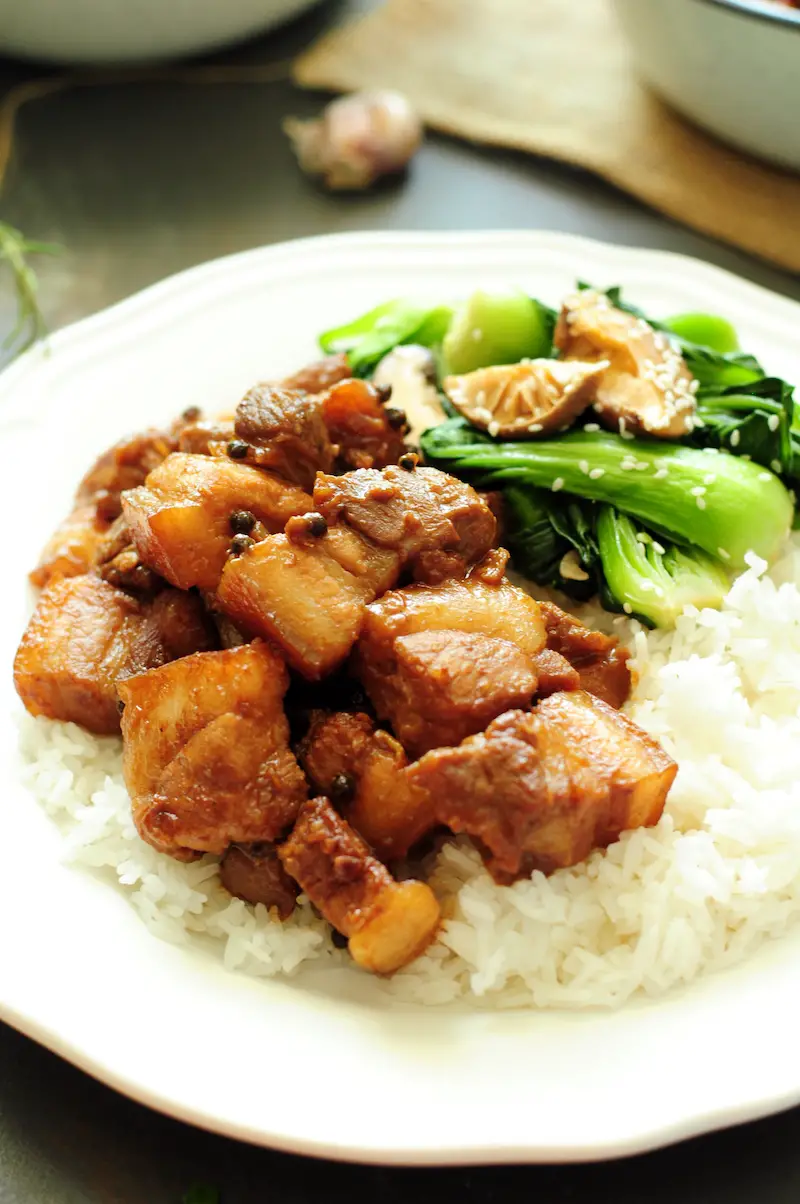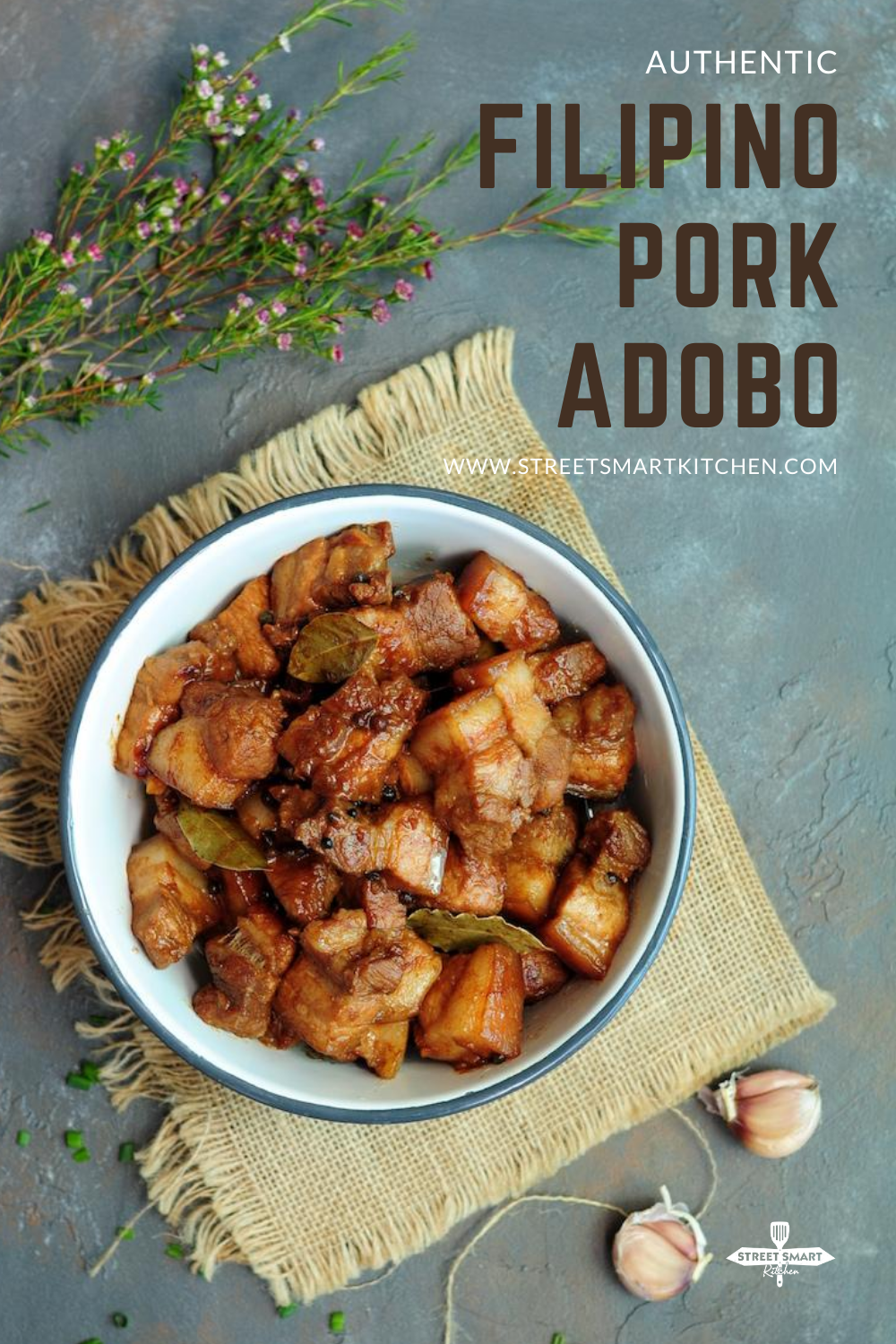All Things Pork Adobo with an Authentic Filipino Recipe
Bring the most authentic Filipino pork adobo taste home with this essential recipe and learn all the surprising variations you can make.

Have ever had legit Filipino pork adobo before? It’s a perfect blend of savory, tangy, salty, and sweet. No wonder it’s one of the most treasured national dishes of the Philippines. The taste is truly addictive.
What is Pork Adobo?
The word adobo originates from the Spanish word “adobar,” which means to marinate. So adobo is actually more a cooking method than a type of food. Adobo can be used to flavor all kinds of meat, seafood, vegetables, and tofu. It makes any plain or bland dish dance on your tastebuds.
When you make pork adobo, you’re simply cooking and simmering a cut of pork in a base of vinegar, soy sauce, garlic, and black peppercorns. The correct ratio of vinegar and soy sauce is key to a delicious adobo, otherwise the taste can be dramatically altered and off-putting.
Some pork adobo recipes add other ingredients to deepen the flavor, such as oyster sauce, sugar, and onion. Simply delicious!
Many cultures have their own version of adobo with different herbs, spices, and flavor profiles. For example, Filipino adobo tastes salty and sour, while Mexican or Spanish adobo is typically spicy, made with chilies, oregano, and cinnamon.

Four Main Types of Filipino Pork Adobo
An interesting fact about this Filipino dish is that every region in the Philippines has its own version.
- Pork adobo Ilocano version: This version marinates the pork in oyster sauce, soy sauce, and vinegar along with brown sugar and aromatics before cooking. The recipe included in this post is an Ilocano version of pork adobo.
- Pork adobo Tagalog version: This version uses the same ingredients as the Ilocano version. The difference is that the pork is not marinated beforehand; all the adobo sauce ingredients are added while cooking. It’s often known as pork adobo without marinade.
- Pork adobo Kapangpangan version: This version cooks the pork along with all sauce ingredients except water in a pan until the pork is tender. Then the pork is browned in cooking oil and simmered in water.
- Pork adobo Bisaya version: Adobo Bisaya is always marinated and then fried; the pork is not simmered in soy-vinegar sauce.
Those are the main types of pork adobo across the Philippine archipelago. Over time, home cooks have put different creative spins on this Filipino national dish. Starting with the basic recipe, which is included at the end of this post, they’ve experimented with many variations. Here are a few for your inspiration.
Pork Adobo Variations

Pork Adobo with Pineapple
Adding juicy pineapple elevates the sweet and sour flavor of the basic pork adobo. There are a couple ways of making the adobo with fresh pineapple chunks.
You may caramelise pineapple chunks in oil over medium-high heat for about 5 minutes until there’s a golden crust on each chunk. Then add the caramelised pineapples to the simmering pork adobo to cook for another 20 minutes until the sauce is thickened.
You may also add pineapple juice to the adobo sauce for simmering and stir in fresh pineapple chunks at last to finish off the dish.
If adding pineapples to your adobo, you don’t need any sugar for cooking, which is what I prefer.
Pork Adobo with Eggs
Whenever I make my mom’s Shanghai-Style Braised Pork Belly, I always add eggs. Similarly, you can add eggs to Filipino pork adobo as well. The eggs are precooked and peeled. In order for the eggs to absorb the delicious flavor and appetizing color of the adobo sauce, they are simmered in the sauce with the pork during the last 20 minutes of the cooking process. I personally really don’t like those overcooked eggs with yolks that taste like powder. So one tip here is to make soft-boiled eggs, then add to the pork adobo for finishing.

Pork Adobo with Potato
This variation is pretty straightforward. You cook potatoes together with the pork in the adobo sauce. The potatoes soak up the sauce, and you’ve got your starchy carbs right there in the dish.
Pork Adobo with Sprite
Got a can of Sprite? Use it to replace the sugar in your pork adobo marinade. As the marinade is going to be pretty saucy, you’d want to strain it before frying the pork and reserve the marinade as a cooking sauce during simmering. Sprite pork adobo is on the sweet side if that’s what you prefer.
Pork and Chicken Adobo
Love chicken adobo as well? Why don’t we combine pork and chicken and use the same recipe to make it even more irresistible?
What Cut of Pork to Use?
Pork belly is hands down the best choice for pork adobo. If you want to cut down on the fat, you can certainly use a leaner cut such as pork shoulder or pork tenderloin. Pork leg and pork chops can also work for this recipe. I suggest you keep an eye on the meat while cooking because different cuts might need different amounts of simmering time than pork belly.

How to Cook Pork Adobo?
To cook an authentic pork adobo, you only need to follow a few simple steps. Let’s get to it.
1. Marinate the pork.
I prefer to marinate my pork belly with soy sauce, oyster sauce, brown sugar, apple cider vinegar or white vinegar, whole peppercorns, minced onions and lots of garlic overnight to maximize the flavor. You could leave the vinegar and onions out of the marinade and add those ingredients while cooking if you prefer.
2. Strain the pork.
Before cooking, drain the pork to separate the liquid marinade as much as possible, especially if you want to use Sprite or pineapple juice for a different and interesting taste. This step will ensure that the pork browns well when it hits the hot oil.
3. Sear the pork and simmer.
Start by heating oil over high heat. Place the marinated pork in the hot pan and brown all sides. Once the pork is seared, pour the reserved marinade and water into the pan, bring to a boil, then switch the heat down to low. You are going to let the pork tenderize nicely and slowly. Allow at least 40 minutes, but sometimes your pork might need a bit more time.

Can I Make Pork Adobo in a Slow Cooker?
You bet! All you need to do is to combine all of the ingredients in a slow cooker. If you prefer, you can put the spices and bay leaves into a cheese cloth and tie it up before adding it. Cook on high for 5-6 hours or on low for 8-10 hours until the pork is fall-off-the-bones tender. The same method can be used for cooking chicken adobo. Cut down the cooking time to 3-4 hours on high and 6-8 hours on low if using chicken.
I am sure you can also make it in an Instant Pot, and I experimented with sous vide which turned out absolutely phenomenal.
Is Pork Adobo Keto Friendly?
It certainly can be, and here’s what to keep in mind for a keto-friendly and low-carb pork adobo.
- Substitute brown erythritol for the brown sugar. Brown erythritol is a natural low-carb sweetener known as sugar alcohol that’s about 70% as sweet as refined sugar. It has 95% fewer calories than sugar, so it makes a perfect sugar substitute when you are on the keto diet.
- Substitute Worcestershire sauce for the oyster sauce because oyster sauce contains too many ingredients that are not keto-approved, including added sugars, preservatives (like MSG), thickening agents (such as cornstarch), and even artificial coloring.
- Serve with cauliflower rice instead of white rice to keep your carb consumption at bay.
What to Serve with Pork Adobo?
You can serve it with almost anything. Traditionally, it’s served on a bed of white rice or with a light green salad or vegetable such as green beans, bok choy, or spinach. You can also serve it with cauliflower rice for a low-carb and Paleo-friendly option.


Authentic Filipino Pork Adobo Recipe
- Prep Time: 15 minutes
- Cook Time: 50 minutes
- Total Time: 65 minutes
- Yield: 6 servings 1x
- Category: Meat
- Method: Stove
- Cuisine: Filipino
Description
Bring the most authentic Filipino pork adobo taste home with this essential recipe.
Ingredients
- 1 3-pound slab of pork belly, boneless and skin on, cut into bite-sized pieces
- 1 cup water
- 4 bay leaves
- Salt to taste
For the marinade:
- 1/2 cup light soy sauce
- 1/4 cup vinegar (I used apple cider vinegar)
- 2 tablespoons oyster sauce
- 1 medium onion, diced
- 1 teaspoon brown sugar
- 1 tablespoon whole black peppercorns
- 5 cloves garlic, minced (about 3 tablespoons)
Instructions
- Rinse prepared pork belly and drain well. Place it in a large mixing bowl.
- Add all the marinade ingredients into the mixing bowl and stir well. Make sure that all pork belly pieces are coated with the marinade. Cover and place in the fridge for at least an hour. Marinate overnight if desired.
- When ready to cook, heat up a dutch oven, a wok, or a large sauté pan over high heat, about 1 minute. Remove pork from the fridge.
- Transfer the marinated pork into the hot pan with marinade, sauté for about 2 minutes, or until the pork is lightly browned.
- Add water and bay leaves, bring to a boil. Switch to low heat and simmer for 30-45 minutes, covered or until the pork is tender. Sprinkle with a dash of salt to taste if needed. Serve over rice and pair with a green leafy vegetable dish to round out your meal.
Nutrition
- Serving Size: 1
- Calories: 472
- Sugar: 2.4g
- Sodium: 750.6mg
- Fat: 44.9g
- Saturated Fat: 15.2g
- Carbohydrates: 7.5g
- Fiber: 0.8g
- Protein: 9.2g
- Cholesterol: 54.4mg

About the Author
Sharon Chen is an Integrative Nutrition Health Coach and author of the Complete Sous Vide Cookbook. She believes food not only brings healing but also connection. As the creator of StreetSmart Kitchen, she aims to make meal prep easier than ever and help you find balance, ease, joy, and simplicity in the kitchen as you improve your well-being.



Pingback: 30 Easy Asian Pork Recipes - Insanely Good
My mother’s adobo recipe is from a woman whose husband was a school superintendent in the Philippines. Your description tells me that ours is the Tagalog version. I have a pair of carved Igorot heads that my father purchased in 1952 when he was in the Navy. I treasure them and the recipe.
Thank you for sharing the family story about your mother’s adobo recipe. Mom’s recipes are the best!
I woke up one Monday morning a little over 46 years ago and realized that the day before I had married a young Filipina who didn’t know how to cook American food. Oh noes…
She talked me into agreeing to let her cook her food for three months, and then I could decide if I liked it or not. If not, she would give it up for me. What a sweetheart.
She cheated. She fixed pork adobo for the first meal.
To say I was immediately hooked was an understatement. For the next few days all I wanted to eat for dinner was more pork adobo. It turned into a gateway drug for other foods such as kare kare, pinakbet, sinagang and many more. Even now, when we go visit her family in the PI they are amazed at their food I pack away.
Another story… when our daughter was away at college in a small, liberal arts school in Arkansas she lived in a three story dorm. She would go down to the basement kitchen every couple weeks and fix a big pot of adobo for herself. After about 30 minutes the kitchen would be crowded with girls from all three floors, wanting to know what that wonderful smell was. She converted many Southern girls into being adobo eaters those years. I am sure decades from now there will be young kids wondering why they eat adobo so much without knowing that their grandmas learned it from a half-Pinay college classmate.
What a story! Thanks so much for sharing, Jack! I enjoyed reading it. 🙂
This is so good!! Everyone at my house is now requesting for it!! Such a huge hit!
This looks simply irresistible and I love all the variations you offer. I’m going to try this with pineapple – YUM.
Love your recipe to making some amazing pork. This recipe is so flavorful. Love the glaze and the delicious combinations to this dish.
Wow! Irish soda bread…so easy and delicious! This is going into the weeknight dinner rotation. Thanks for sharing 🙂
Oh I definitly have to try this! When I travelled to the Philippines a few years ago I fell in love with adobo sauce (even if adobo is more a cooking method as you say I think that sauce was pretty similar to yours) – only had it with chicken though so I am super excited about this pork version!!